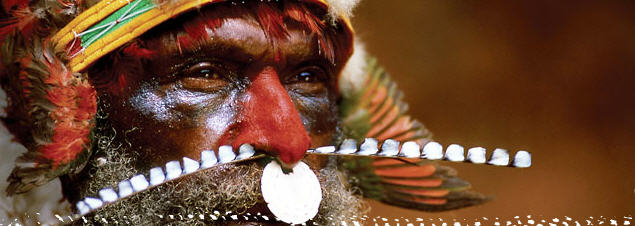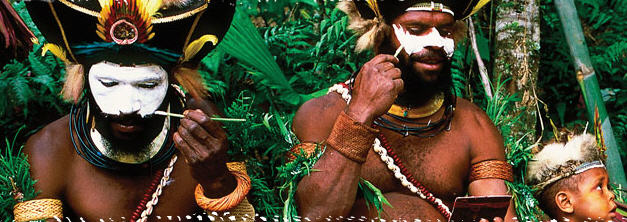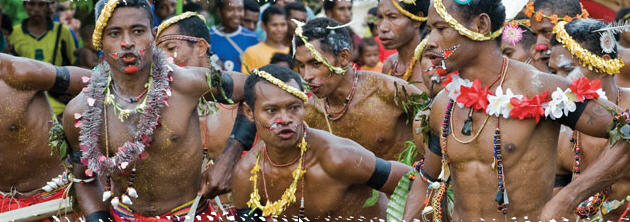The cultural festival season in Papua New Guinea starts in June and runs until November each year. Important aspects of Papua New Guinea culture, such as tribal dance and song (known as Sing-Sings), elaborate masks and costumes and traditional rituals take place at these annual events.
The National Mask Festival starts in mid-July and is organized by the PNG Cultural Commission is an annual event usually stated in Rabaul.
The festival is the main forum where Papua New Guinea’s mask culture is showcased by performers from all over the country where both common and rare masks are displayed.
Three major categories of mask are displayed and they are: the spirit masks, the ancestor masks and the tumbuan masks.
Mt. Hagen Cultural Show: This event was first staged in 1964 by many different tribes from Western Highlands Province.
The show was for the purpose of sharing the cultural experience with each other, calming the ever-present tribal animosities and enmities by bringing all tribes together in a one cultural event to expose the positive side of life, and to celebrate the diversity of cultures among the natives.
In 1964, Papua New Guinea was still under its colonial power, Australia. Between 1964 and 2002, there has been some huge paradigm shifts, which has meant that the focus of the show has also shifted. The Mt. Hagen Cultural Show now focuses on tourist entertainment and is designed to attract international and domestic travellers. There is also now prize money on offer for the winning cultural group, which makes the competition aggressive, colourful and exciting.
Over 50 different cultural groups perform their different dances (or “singsings”) for the tourists. Local musicians and other modern entertainment events and attractions also occur during the show. It is held in August.
The Goroka Cultural Event: The Eastern Highlands Cultural Show which is simply known as the ‘Goroka Show’ is a significant event in the province.
The Goroka Show is a probably the most well-known tribal gathering and cultural event in Papua New Guinea. It is held every year, during the weekend closest to Independence Day (16th September), in the town of Goroka. About 100 tribes arrive to show their music, dance and extraordinary displays of tribal rituals. Although the festival started in the mid 1950s, from the initiative of missionaries, the Goroka show now offers a rare opportunity for travelers to experience the customs of over a hundred tribes that populate the Papua New Guinea highlands.
The staging of the Goroka Show started back in 1957 at the Independence Park, opposite the Goroka Main Market. The show was first introduced and organized by Australian Kiaps (patrol officers). Kiaps from each district built round houses typical of their districts. It is here that they proudly displayed cultures of their districts. The kiaps brought in singsing groups from their area and as we have some twenty-nine languages and societies, it was reflected in their culture. It began as an entertainment weekend for everybody in the Province. The show was also a competition to see who the best organized and administered district was. It is held in September.
The Annual Crocodile Festival: The event takes place usually around the final week of October, to early November. Prizes are given to winning groups and the canoes are assembled a day earlier at Wagawaga Island, to form a convoy before sailing to Alotau for the official opening ceremony.A two-day festival celebrates the region’s pristine environment and wildlife.
The WWF-supported crocodile festival in East Sepik highlights the importance of crocodile conservation and the species’ habitat along the Sepik River, one of the largest unpolluted rivers in the Asia-Pacific region.
The Sepik River is home to some of the world’s largest freshwater and saltwater crocodile populations.Crocodiles are part of the Sepik heritage. Men and crocodile share a special bond. The Crocodile symbolize strength, power and manhood. Many boast of scars cut into their skin during initiation. The scars resembling the back of a crocodile run from the shoulder to hip.
National Canoe and Kundu Festival: The event starts in January and ends in March. Canoes and the Kundu drums are a significant aspect of the lives of the people of Milne Bay, Papua New Guinea. Both the Canoe and the Kundu were widely used in olden times in ceremonies and rituals and were meticulously crafted from special woods under strict customs, to derive the best results and to appease the gods.
The National Canoe and Kundu Festival was first held in Milne Bay in 2003. The canoes that are used in the festival are crafted in the same way that the canoes were crafted many years ago by the people’s ancestors. The colours and patterns reflect upon the tribe and the area the canoe comes from. The canoes and traditional dancing groups come from all over the Milne Bay province, including some parts of the Papuan Region.

Renee Blodgett is the founder of We Blog the World. The site combines the magic of an online culture and travel magazine with a global blog network and has contributors from every continent in the world. Having lived in 10 countries and explored nearly 80, she is an avid traveler, and a lover, observer and participant in cultural diversity.
She is also the CEO and founder of Magic Sauce Media, a new media services consultancy focused on viral marketing, social media, branding, events and PR. For over 20 years, she has helped companies from 12 countries get traction in the market. Known for her global and organic approach to product and corporate launches, Renee practices what she pitches and as an active user of social media, she helps clients navigate digital waters from around the world. Renee has been blogging for over 16 years and regularly writes on her personal blog Down the Avenue, Huffington Post, BlogHer, We Blog the World and other sites. She was ranked #12 Social Media Influencer by Forbes Magazine and is listed as a new media influencer and game changer on various sites and books on the new media revolution. In 2013, she was listed as the 6th most influential woman in social media by Forbes Magazine on a Top 20 List.
Her passion for art, storytelling and photography led to the launch of Magic Sauce Photography, which is a visual extension of her writing, the result of which has led to producing six photo books: Galapagos Islands, London, South Africa, Rome, Urbanization and Ecuador.
Renee is also the co-founder of Traveling Geeks, an initiative that brings entrepreneurs, thought leaders, bloggers, creators, curators and influencers to other countries to share and learn from peers, governments, corporations, and the general public in order to educate, share, evaluate, and promote innovative technologies.













